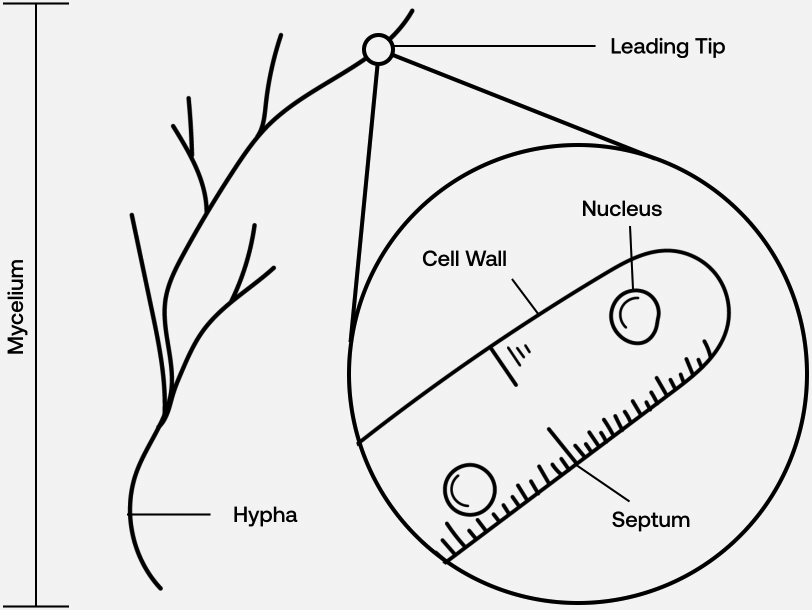
Mycelium 101
“Mushrooms are not like an animal, and not like a vegetable, but somewhere in between.”
-Eugenia Bone

Fungi are an entire kingdom of life.
With 1.5 million discovered species, and an estimated six times more species than plants, fungi are hyperdiverse and extremely important to the functioning of life on Earth. Humans are only scratching the surface of all the fungi that exist, but they are almost everywhere, connected in some way to almost every living thing.
There’s more to fungi than mushrooms, which are essentially reproductive organs, analogous to the apple of a tree. A fungus is a eukaryotic organism, meaning that similar to animals — and unlike prokaryotes such as bacteria — fungal cells contain a nucleus rather than free-floating DNA. Also like us, they are heterotrophic, which means they have to eat their food, different from photosynthesizing plants which receive their energy from sunlight.
Fungi often take the form of a filamentous web called mycelium, made of individually linked cells called hyphae. Mycelia and their hyphae spread throughout their environments, secreting enzymes that dissolve their food so that it can be absorbed into their cells. In the process, these fungal networks bind the soil together, connect the trees of the forest, and churn living and dead organic matter into the makings of new life.
Fungi are the great
recyclers of Earth.
The Kingdom of Fungi is divided into two main categories

Single-celled
• Free-floating spherical cells
• Clustered morphology (think baker’s yeast)
• Not used in Ecovative’s technology

Multi-cellular
• Strands of interconnected cells
• Branching morphology (think spider web)
• Used in Ecovative’s technology
Lifecycle of a fungus

Pinhead
Forms after certain age and when
environmental conditions are met
Mature Mushroom
After maturity is reached, spores
inside the mushroom will drop and
float away with the wind, starting
the lifecycle again.
Spores
Germinate like seeds and begin to
branch under the soil
Mycelium
The continuous branching network of hyphae
is called a mycelium.
Hyphae
Germinated spores shoot off roots into
the ground called hyphae.
Ecovative’s technology utilizes the adaptability of mycelium.

How does a fungus grow?
Fungi live in cyclical patterns. Starting as spores, they grow into mycelium, which then generates mushrooms that in turn produce more spores, beginning the cycle anew.
The last cell at the end of each hypha is called the “leading tip,” and is where the majority of metabolic activity occurs. There, an incredibly tiny, incredibly complex biological structure called a ‘Spitzenkörper’ constantly produces new hyphal material in its constant search for more food, whether wood chips, hemp particles, soy hulls, or anything else.
There are countless hyphae in a mycelial web, as it constantly divides and grows. Follow any branch to the tip and they are all working in the same way, excreting enzymes to digest the food source the mycelium is growing in, or to fend off competition. As it grows, the mycelium creates a nearly solid structure within its digested substrate.
At Ecovative, we have learned how to guide this growth process to create a wide range of natural, biodegradable materials, from textiles to meats to fashion products and beyond.









